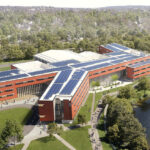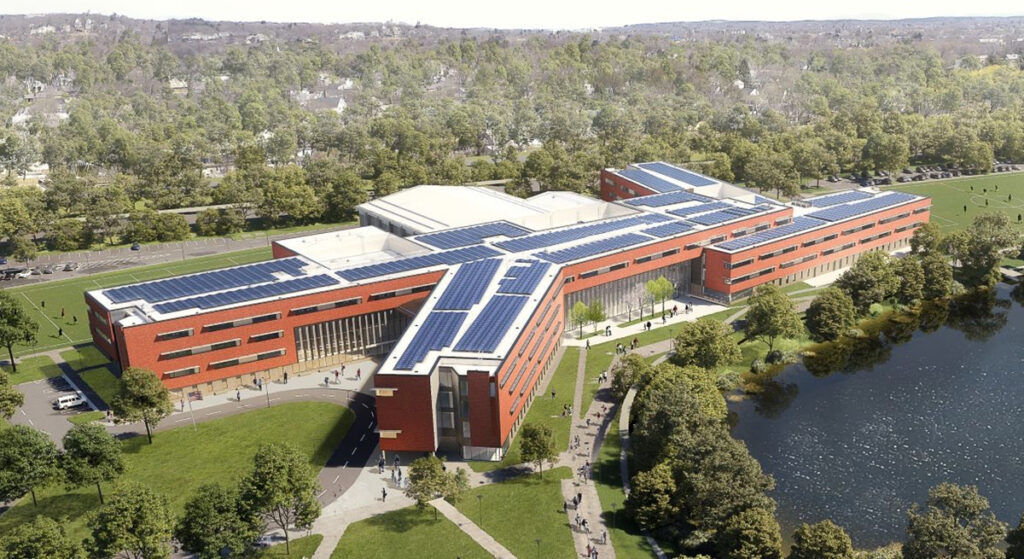
By Brian Iler
Photovoltaic solar panels (PVs) have been planned for the new Belmont Middle and High School (BMHS) since early designs for the project were presented in 2017. PV is integral to achieving this building’s Zero Net Energy goal. And to many in Belmont, Zero Net Energy was a big factor when deciding whether to vote for a hefty tax increase to fund this colossal project in 2018.
Since this vote, the funds reserved for PVs have been on the chopping block three times to offset project cost overruns. Public outcry—with advocates crowding into Belmont Middle and High School Building Committee meetings, sending emails to town officials, and building record attendance at Zoom meetings—has convinced the Building Committee that PVs are a “need-to-have” item, not a “nice-to-have,” at least until the next round of cuts is considered.
Public support for PV was unequivocally expressed in spring 2022 when Town Meeting passed Warrant Article 13 by a 91% vote, declaring:
“ . . . the Belmont Town Meeting hereby expresses its desire that the Building Committee will ensure that the BMHS project will include a solar PV facility that maximizes solar energy capacity consistent with the rooftop size, layout, and setbacks, which Facility shall be installed as part of the construction of the BMHS project.”
With this overwhelming political support, the Building Committee prepared bid documents for the school’s PVs last summer, vetted prospective bidders, and received bids in October of 2022.
The bids were revealed at the Building Committee’s November 10 meeting. The low bid (from Griffin Electric) for the full PV array was $2,669,000. This amount seemed to come within a rounding error of the amount budgeted: $2,600,000.
However, this was not the end of the story. Additional PV-related costs were unearthed, and after calculations that only the sharpest construction-budgeting wizard could follow, the Building Committee determined that they were $264,000 short of the amount needed to install the full array (1.14 megawatt-DC). At their next meeting on November 17, they voted to accept a bid for a truncated version: 86% of the full array.
Compared to the full array, this rump array would forfeit $36,000 in electricity cost savings in the first year alone, losing equal if not greater amounts in subsequent years. Also left on the table would be $65,000 in federal grant money (more on this below). Any benefits from the project’s Zero Net Energy rating would also be forfeited.
Some committee members (and many residents who follow this project closely) were alarmed to hear of new PV expenses: $146,923 “to support PV,” which appears on line 19 of the Photovoltaic System Executive Bid Summary, and other expenses that led the committee to conclude they were $264,000 short (since updated to $290,000).
The Building Committee and the community had been assured at many meetings that the original design of the building incorporated all the infrastructure needed to support PV and that the solar array bids included all the items required for PV. This miscalculation calls into question the reliability of the project’s owner’s project manager’s (CHA Consulting) oversight and the architect’s (Perkins & Will) expertise.
Speculation that the last 14% of the solar panels could be added at a later date begs the question: where would the funds come from? Also, the cost of purchasing and installing the panels would likely be considerably more than the current $290,000, as design and bid costs would need to be re-spent, and the logistics of installing the panels on a now-occupied school would be expensive.
A glimmer of hope in this depressing situation came from Washington: the recently passed Inflation Reduction Act includes funds for municipalities that install PV. Preliminary calculations indicate that Belmont is eligible for a grant of up to $665,000 for the full array (less for the truncated array). Caveats include that the money will likely not be available until 2024 or even later, and the funds will go to the town’s general fund to be spent in any way the town wants.
On January 9, the Select Board voted to use federal American Rescue Plan Act (ARPA) money received by the town to “loan” the Building Committee the funds it needs to complete the full array. They found the economic benefits of installing the full PV array as soon as possible to be very persuasive: a $294,633 outlay now will yield $36,000 per year in energy savings and $65,000 in additional federal grant funds.



Sorry, the comment form is closed at this time.